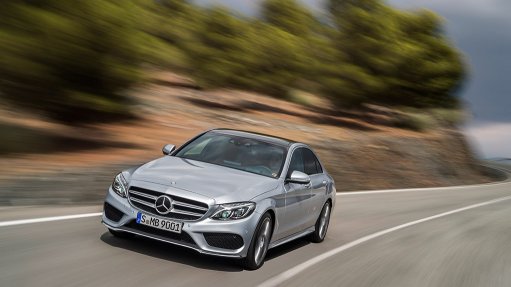
Mercedes-Benz South Africa (MBSA) and Transnet Port Terminals (TPT) have moved to the containerisation of vehicles as MBSA grows and expands the geographical reach of its exports.
MBSA’s plant, based in East London, in 2013 exported 36 234 C-Class vehicles to the US as its only export market.
However, the introduction of the new C-Class last year saw a shift in export markets, with 33 688 units moved to various markets across the globe.
“As our production ramp-up nears its peak, our export figures will also increase in line with increased production. While we cannot divulge production forecast numbers, the plan is to export roughly four out of every five cars produced at the East London plant,” says MBSA CEO and manufacturing VP Arno van der Merwe.
Production of the new vehicle, in left-hand- and right-hand-drive derivatives, has seen capacity at the plant increase from roughly 50 000 C-Class units a year, to around 100 000 units a year.
Investment by MBSA and its Daimler parent company to produce the new C-Class amounted to R5.4-billion.
Export markets increased from one ¬– the US ¬– to roughly 80 markets, creating new challenges for the car manufacturer, and the East London port.
“As the capacity of the car terminal in the East London port remained the same with the change-over at MBSA from the previous C-Class model to the current model, the shipping frequency has been increased by utilising more shipping lines to ship the products to the various markets around the world. As a consequence, more shipping lines are now visiting the East London port than in the past,” says Van der Merwe.
The port has also seen the introduction of the containerisation of cars, as opposed to using only RoRo (roll-on, roll-off) vessels, where the cars are driven onto the ship, and driven off at their destinations.
“A few smaller markets on the globe do require that their C-Class units are shipped in containers,” explains Van der Merwe.
The containerisation of the finished product, however, also offers a positive spin-off.
Many of the assembly parts used at the East London plant are imported in containers, with roughly half of these containers returned containing the packaging material and pallets that are required to pack more parts for a next import delivery, explains Van der Merwe. The other 50% of the import containers usually remain empty.
“To fill these containers with cars for export back to the original market where the parts were shipped from, realises obvious efficiency opportunities,” he notes.
The containerisation operation in the East London port uses the available capacity at both the car and container terminals.
“The East London terminal is currently providing enough capacity for MBSA’s vehicle export operations,” says Van der Merwe.
However, should there be a significant export volume increase in the future, the capacity of the car terminal will have to be revisited in partnership with TPT, he adds.
“The capacity of the present structure can be increased by adding levels to the existing building.
“This would have to be carefully planned though, so as to not negatively impact the flow of product through the port. Alternative solutions such as rail or coastal transshipment could also be considered.”
Van der Merwe says “it would be a positive development for the company” if larger container vessels were able to berth in the East London port, which is restricted by a limited maximum vessel draft.
The East London port container terminal currently handles imported parts containers delivered by large container vessels in Port Elizabeth, and transshipped to East London.
MBSA also imports other parts via Coega, with these parts then road-hauled to the East-London Industrial Development Zone.
TPT is an operating division of State-owned logistics company Transnet.
TPT believes the containerisation of cars will ensure faster turnaround times at the East London port.
The containerisation project, in operation since December, is set to increase automotive volumes by 22 000 units a year, while also growing twenty-foot equivalent unit container traffic by 14 600 units a year.
Each container carries three cars.
TPT has invested around R200 000 to implement the project at the East London port.